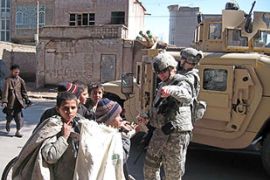US plans to woo Taliban fighters
US defence bill authorises paying Taliban who renounce violence in Kabul.

Reaching out
Reaching out to moderate Taliban members is part of the Obama administration’s plan to turn around the eight-year-long war in Afghanistan.
| in depth | |||||||||||||||
|
Levin also has advocated trying to convince Taliban fighters to change sides by luring them with jobs and amnesty for past attacks.
Under the legislation, Afghan fighters who renounce the violence would be paid for “mainly protection of their towns and villages,” Levin said.
It would be “just like the sons of Iraq,” he said, referring to the programme used in Iraq which military commanders say helped turn around a failing war.
“You got 90,000 Iraqis who switched sides, and are involved in protecting their hometowns against attack and violence.”
The bill authorises using money from an existing Commanders Emergency Response Programme, which US commanders can use for a variety of purposes.
It does not set a specific dollar amount for the fighters’ re-integration programme.
Troop levels
There is $1.3 billion authorised for the fund in fiscal 2010, which began on October 1.
The money must still be allocated by defense appropriators, who are working to finish the legislation.
As part of his overall strategy review on Afghanistan, Obama is debating whether to send more US troops to the region and is set to meet on Friday with Admiral Mike Mullen, chairman of the joint chiefs of staff, and the heads of the military services, the White House said.
The Joint Chiefs office recently completed an internal assessment of the two leading proposals for troop levels in Afghanistan.
These were sending roughly 40,000 additional troops, as his commander for Afghanistan, General Stanley McChrystal, has recommended, or a far smaller number, an option McChrystal and other defense officials see as having a higher risk of failure.
